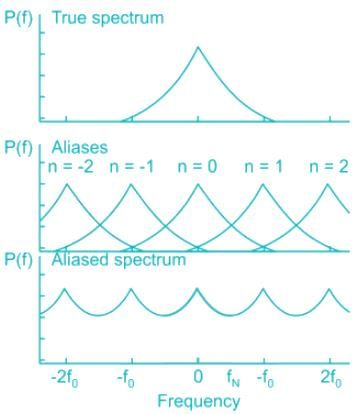Electronics and Communication Engineering (ECE) Exam > Electronics and Communication Engineering (ECE) Questions > A single tone 4 kHz message signal is sampled...
Start Learning for Free
A single tone 4 kHz message signal is sampled with 9 kHz, 7 kHz and 5 kHz. Aliasing effect will be seen in the reconstructed signal, when the signal is sampled with
- a)9 kHz
- b)any of 9 kHz, 7 kHz, or 5 kHz
- c)Both 9 kHz and 7 kHz
- d)Both 7 kHz and 5 kHz
Correct answer is option 'D'. Can you explain this answer?
Most Upvoted Answer
A single tone 4 kHz message signal is sampled with 9 kHz, 7 kHz and 5 ...
Sampling and Aliasing
Sampling is the process of converting a continuous-time signal into a discrete-time signal by taking samples at regular intervals. The sampling rate determines how frequently the samples are taken, and it is usually expressed in samples per second or Hertz (Hz). Aliasing is a phenomenon that occurs when the sampling rate is not sufficient to accurately represent the original signal.
Aliasing Effect
The Nyquist-Shannon sampling theorem states that a signal must be sampled at a rate greater than or equal to twice the highest frequency component of the signal in order to avoid aliasing. If the sampling rate is not sufficient, the higher frequency components of the original signal will fold back into the lower frequency range, resulting in a distorted and unfaithful representation of the original signal.
Analysis of Sampling Rates
In this question, the message signal is a single tone with a frequency of 4 kHz. We are given three sampling rates: 9 kHz, 7 kHz, and 5 kHz. Let's analyze each sampling rate to determine if aliasing will occur.
1. Sampling rate of 9 kHz:
- The Nyquist-Shannon sampling rate for the 4 kHz signal is 8 kHz (twice the signal frequency).
- Since the sampling rate of 9 kHz is greater than the Nyquist rate, there will be no aliasing. The reconstructed signal will accurately represent the original signal.
2. Sampling rate of 7 kHz:
- The Nyquist-Shannon sampling rate for the 4 kHz signal is 8 kHz (twice the signal frequency).
- Since the sampling rate of 7 kHz is less than the Nyquist rate, aliasing will occur. The higher frequency components of the original signal will fold back into the lower frequency range, causing distortion in the reconstructed signal.
3. Sampling rate of 5 kHz:
- The Nyquist-Shannon sampling rate for the 4 kHz signal is 8 kHz (twice the signal frequency).
- Since the sampling rate of 5 kHz is less than the Nyquist rate, aliasing will occur. The higher frequency components of the original signal will fold back into the lower frequency range, causing distortion in the reconstructed signal.
Conclusion
Based on the analysis, we can conclude that aliasing will occur in the reconstructed signal when the signal is sampled at a rate of 7 kHz or 5 kHz. The sampling rate of 9 kHz is sufficient to avoid aliasing, and the reconstructed signal will accurately represent the original signal. Therefore, the correct answer is option 'D' - aliasing will occur when the signal is sampled at both 7 kHz and 5 kHz.
Sampling is the process of converting a continuous-time signal into a discrete-time signal by taking samples at regular intervals. The sampling rate determines how frequently the samples are taken, and it is usually expressed in samples per second or Hertz (Hz). Aliasing is a phenomenon that occurs when the sampling rate is not sufficient to accurately represent the original signal.
Aliasing Effect
The Nyquist-Shannon sampling theorem states that a signal must be sampled at a rate greater than or equal to twice the highest frequency component of the signal in order to avoid aliasing. If the sampling rate is not sufficient, the higher frequency components of the original signal will fold back into the lower frequency range, resulting in a distorted and unfaithful representation of the original signal.
Analysis of Sampling Rates
In this question, the message signal is a single tone with a frequency of 4 kHz. We are given three sampling rates: 9 kHz, 7 kHz, and 5 kHz. Let's analyze each sampling rate to determine if aliasing will occur.
1. Sampling rate of 9 kHz:
- The Nyquist-Shannon sampling rate for the 4 kHz signal is 8 kHz (twice the signal frequency).
- Since the sampling rate of 9 kHz is greater than the Nyquist rate, there will be no aliasing. The reconstructed signal will accurately represent the original signal.
2. Sampling rate of 7 kHz:
- The Nyquist-Shannon sampling rate for the 4 kHz signal is 8 kHz (twice the signal frequency).
- Since the sampling rate of 7 kHz is less than the Nyquist rate, aliasing will occur. The higher frequency components of the original signal will fold back into the lower frequency range, causing distortion in the reconstructed signal.
3. Sampling rate of 5 kHz:
- The Nyquist-Shannon sampling rate for the 4 kHz signal is 8 kHz (twice the signal frequency).
- Since the sampling rate of 5 kHz is less than the Nyquist rate, aliasing will occur. The higher frequency components of the original signal will fold back into the lower frequency range, causing distortion in the reconstructed signal.
Conclusion
Based on the analysis, we can conclude that aliasing will occur in the reconstructed signal when the signal is sampled at a rate of 7 kHz or 5 kHz. The sampling rate of 9 kHz is sufficient to avoid aliasing, and the reconstructed signal will accurately represent the original signal. Therefore, the correct answer is option 'D' - aliasing will occur when the signal is sampled at both 7 kHz and 5 kHz.
Free Test
FREE
| Start Free Test |
Community Answer
A single tone 4 kHz message signal is sampled with 9 kHz, 7 kHz and 5 ...
Concept:
The sampling theorem states that “a signal can be exactly reproduced if it is sampled at the rate fs which is greater than twice the maximum frequency W in the modulating signal."
If the sampled frequency is less than the Nyquist frequency, overlapping of lower and upper sidebands known as aliasing takes place.
The main reason for aliasing is under-sampling, i.e. sampling the signal at a frequency less than twice the Nyquist rate.
fs < 2fm
fs = Sampling frequency
fm = Modulating frequency
Application:
The minimum sampling rate to avoid aliasing will be:
fs = 2 × 2fm = 2 × 4 kHz
fs = 8 kHz
∴ For fs ≥ 8 kHz, the sampling frequency will satisfy the Nyquist rate and no aliasing will take place.
And for both 7 kHz and 5 kHz sampling rates, the Aliasing effect will be seen in the reconstructed signal as the sampling frequency is less than the Nyquist Rate.
The sampling theorem states that “a signal can be exactly reproduced if it is sampled at the rate fs which is greater than twice the maximum frequency W in the modulating signal."
If the sampled frequency is less than the Nyquist frequency, overlapping of lower and upper sidebands known as aliasing takes place.
The main reason for aliasing is under-sampling, i.e. sampling the signal at a frequency less than twice the Nyquist rate.
fs < 2fm
fs = Sampling frequency
fm = Modulating frequency
Application:
The minimum sampling rate to avoid aliasing will be:
fs = 2 × 2fm = 2 × 4 kHz
fs = 8 kHz
∴ For fs ≥ 8 kHz, the sampling frequency will satisfy the Nyquist rate and no aliasing will take place.
And for both 7 kHz and 5 kHz sampling rates, the Aliasing effect will be seen in the reconstructed signal as the sampling frequency is less than the Nyquist Rate.
Aliasing is explained with the help of the spectrum as shown:



|
Explore Courses for Electronics and Communication Engineering (ECE) exam
|

|
Question Description
A single tone 4 kHz message signal is sampled with 9 kHz, 7 kHz and 5 kHz. Aliasing effect will be seen in the reconstructed signal, when the signal is sampled witha)9 kHzb)any of 9 kHz, 7 kHz, or 5 kHzc)Both 9 kHz and 7 kHzd)Both 7 kHz and 5 kHzCorrect answer is option 'D'. Can you explain this answer? for Electronics and Communication Engineering (ECE) 2025 is part of Electronics and Communication Engineering (ECE) preparation. The Question and answers have been prepared according to the Electronics and Communication Engineering (ECE) exam syllabus. Information about A single tone 4 kHz message signal is sampled with 9 kHz, 7 kHz and 5 kHz. Aliasing effect will be seen in the reconstructed signal, when the signal is sampled witha)9 kHzb)any of 9 kHz, 7 kHz, or 5 kHzc)Both 9 kHz and 7 kHzd)Both 7 kHz and 5 kHzCorrect answer is option 'D'. Can you explain this answer? covers all topics & solutions for Electronics and Communication Engineering (ECE) 2025 Exam. Find important definitions, questions, meanings, examples, exercises and tests below for A single tone 4 kHz message signal is sampled with 9 kHz, 7 kHz and 5 kHz. Aliasing effect will be seen in the reconstructed signal, when the signal is sampled witha)9 kHzb)any of 9 kHz, 7 kHz, or 5 kHzc)Both 9 kHz and 7 kHzd)Both 7 kHz and 5 kHzCorrect answer is option 'D'. Can you explain this answer?.
A single tone 4 kHz message signal is sampled with 9 kHz, 7 kHz and 5 kHz. Aliasing effect will be seen in the reconstructed signal, when the signal is sampled witha)9 kHzb)any of 9 kHz, 7 kHz, or 5 kHzc)Both 9 kHz and 7 kHzd)Both 7 kHz and 5 kHzCorrect answer is option 'D'. Can you explain this answer? for Electronics and Communication Engineering (ECE) 2025 is part of Electronics and Communication Engineering (ECE) preparation. The Question and answers have been prepared according to the Electronics and Communication Engineering (ECE) exam syllabus. Information about A single tone 4 kHz message signal is sampled with 9 kHz, 7 kHz and 5 kHz. Aliasing effect will be seen in the reconstructed signal, when the signal is sampled witha)9 kHzb)any of 9 kHz, 7 kHz, or 5 kHzc)Both 9 kHz and 7 kHzd)Both 7 kHz and 5 kHzCorrect answer is option 'D'. Can you explain this answer? covers all topics & solutions for Electronics and Communication Engineering (ECE) 2025 Exam. Find important definitions, questions, meanings, examples, exercises and tests below for A single tone 4 kHz message signal is sampled with 9 kHz, 7 kHz and 5 kHz. Aliasing effect will be seen in the reconstructed signal, when the signal is sampled witha)9 kHzb)any of 9 kHz, 7 kHz, or 5 kHzc)Both 9 kHz and 7 kHzd)Both 7 kHz and 5 kHzCorrect answer is option 'D'. Can you explain this answer?.
Solutions for A single tone 4 kHz message signal is sampled with 9 kHz, 7 kHz and 5 kHz. Aliasing effect will be seen in the reconstructed signal, when the signal is sampled witha)9 kHzb)any of 9 kHz, 7 kHz, or 5 kHzc)Both 9 kHz and 7 kHzd)Both 7 kHz and 5 kHzCorrect answer is option 'D'. Can you explain this answer? in English & in Hindi are available as part of our courses for Electronics and Communication Engineering (ECE).
Download more important topics, notes, lectures and mock test series for Electronics and Communication Engineering (ECE) Exam by signing up for free.
Here you can find the meaning of A single tone 4 kHz message signal is sampled with 9 kHz, 7 kHz and 5 kHz. Aliasing effect will be seen in the reconstructed signal, when the signal is sampled witha)9 kHzb)any of 9 kHz, 7 kHz, or 5 kHzc)Both 9 kHz and 7 kHzd)Both 7 kHz and 5 kHzCorrect answer is option 'D'. Can you explain this answer? defined & explained in the simplest way possible. Besides giving the explanation of
A single tone 4 kHz message signal is sampled with 9 kHz, 7 kHz and 5 kHz. Aliasing effect will be seen in the reconstructed signal, when the signal is sampled witha)9 kHzb)any of 9 kHz, 7 kHz, or 5 kHzc)Both 9 kHz and 7 kHzd)Both 7 kHz and 5 kHzCorrect answer is option 'D'. Can you explain this answer?, a detailed solution for A single tone 4 kHz message signal is sampled with 9 kHz, 7 kHz and 5 kHz. Aliasing effect will be seen in the reconstructed signal, when the signal is sampled witha)9 kHzb)any of 9 kHz, 7 kHz, or 5 kHzc)Both 9 kHz and 7 kHzd)Both 7 kHz and 5 kHzCorrect answer is option 'D'. Can you explain this answer? has been provided alongside types of A single tone 4 kHz message signal is sampled with 9 kHz, 7 kHz and 5 kHz. Aliasing effect will be seen in the reconstructed signal, when the signal is sampled witha)9 kHzb)any of 9 kHz, 7 kHz, or 5 kHzc)Both 9 kHz and 7 kHzd)Both 7 kHz and 5 kHzCorrect answer is option 'D'. Can you explain this answer? theory, EduRev gives you an
ample number of questions to practice A single tone 4 kHz message signal is sampled with 9 kHz, 7 kHz and 5 kHz. Aliasing effect will be seen in the reconstructed signal, when the signal is sampled witha)9 kHzb)any of 9 kHz, 7 kHz, or 5 kHzc)Both 9 kHz and 7 kHzd)Both 7 kHz and 5 kHzCorrect answer is option 'D'. Can you explain this answer? tests, examples and also practice Electronics and Communication Engineering (ECE) tests.

|
Explore Courses for Electronics and Communication Engineering (ECE) exam
|

|
Signup for Free!
Signup to see your scores go up within 7 days! Learn & Practice with 1000+ FREE Notes, Videos & Tests.


















